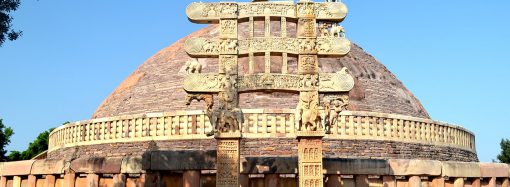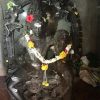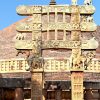To the north of Pune lie rock-cut complexes as startling as Petra but completely overlooked by tourists The valley was wide and fertile, still green despite the onset of the Indian summer heat. On the horizon, the hilltops were jagged with the silhouetted crenellations of Maratha forts. Below, in the valley bottom, white oxen with
To the north of Pune lie rock-cut complexes as startling as Petra but completely overlooked by tourists
The valley was wide and fertile, still green despite the onset of the Indian summer heat. On the horizon, the hilltops were jagged with the silhouetted crenellations of Maratha forts. Below, in the valley bottom, white oxen with blue-painted horns dragged wooden ploughs through rocky strip fields. The second harvest of the year had just been reaped, and the land was being prepared for the fallow months of blazing heat ahead.
The path, though unmarked from the Tarmac road and quite deserted, was an ancient one, rubbed into a U-shaped hollow by the footfalls of generations of pilgrims. It was a steep climb up the old path in the midday sun, and I stopped every few hundred yards to mop my brow. Mynahs hopped chattering around my feet, apparently impervious to the intense heat radiating from the walls of dark rock. Thirty minutes later, finally turning the corner of the cliff, I looked on to the great façade of the building that had drawn so many generations puffing up this hill: the elaborately sculpted portico of probably the oldest intact Buddhist monastery in the world.
The great hall of Bhaja is built into the side of a cliff face, high in the Western Ghats. It lies to the north of Pune in the wild heartlands of the Deccan, and dates from the early 2nd century BC. Open to the environment at one end, and entered by a magnificent 9m-tall horseshoe-arch, it still miraculously preserves its ancient wooden roof beams, like the wrecked keel of a prehistoric ark. These wooden shards crown one of the oldest rooms in the world: a ribbed chaitya hall lined with tapering octagonal columns, ending in a rounded apse that encloses the perfect dome of a tall stone stupa.
Bhaja is usually described as a cave temple but it is really more like sculpture on an epic scale: an entire range of monastic buildings hewn out of the rock and elaborately decorated with sculpted trompe l’oeil. Carved window frames, blind arches and tiers of fretwork mouldings give way to bamboo railings and balconies out of which half-naked Satavahana men and women peer, as if gazing out arm in arm from the terrace of their apartment block, surveying the valley below. These carvings mimic long-lost multi-storeyed wooden buildings, all physical traces of which vanished millennia ago.
And that is, in a sense, the point: as one inscription puts it, these chaitya halls were made to endure a kalpa – an entire cosmic age. The dedication in a neighbouring Deccan cave complex gives an indication of the motives of the patrons who paid for this work: “Realizing that life, youth, wealth and happiness are transitory,” it reads, Varahadeva, prime minister to the great emperor Harisena, “made this dwelling to be occupied by the best of ascetics. It resembles the palaces of the Lord of the Gods, clothed in the brilliance of Indra’s crown. As long as the sun shines this spotless cave may be enjoyed!”
Flanking the chaitya hall lies a vihara, once used for community discussions and theological debates; beyond extend the monastic living quarters. One cave whose roof is still black with petrified soot was presumably a kitchen; to one side, meals were eaten on a long, low platform in the centre of what was clearly the refectory. Beyond that are the lines of austere dormitory cells, each with two stone beds crowned with stone pillows. Carved into each is a bookshelf for holy texts, a rod on which to hang monastic robes, and a wall niche for an oil lamp. The monks could have vacated yesterday, and equipped with a sleeping mat to roll out, could move back tomorrow.
![]()
The hall at Karle
At the end of the halls and cells is the jagged roofline of a natural cave which shelters a cluster of 14 circular stupas, containing the ashes of the monastery’s saints and abbots, ranging from the 3rd century BC to the 2nd century AD. Beyond is carved a magnificent frieze of the heavens, full of restless, churning energy. Some believe it shows the Sun God Surya in his four-horse chariot, with two female attendants and an escort of armed guards, trampling underfoot the coils of the demon of darkness.
These cells and monastic debating halls were already 200 years old when Augustus started the rebuilding of Rome, or when Jesus of Nazareth led his first disciples into the fastness of the Judaean hills. Yet while the more famous of the Deccan rock monasteries – Ajanta and Ellora – are on a few itineraries, these remarkable buildings, representing some of the deepest roots of Indian art, are now quite overlooked except for the occasional visit from specialist art historians and archaeologists. On a 10-day journey around them, I saw barely a handful of other visitors, and they were all curious locals.
These amazing masterworks of early Buddhist art and architecture are the prototypes of the forms that would later spread over the Himalayas to Afghanistan, China and Japan, or by sea to Sri Lanka, Myanmar, Thailand, Cambodia, and the rest of southeast Asia. The roots of all this lie scattered around these stark Maharashtrian hills, alone among the precipices and dragon’s back peaks, apparently forgotten and ignored by all.
“You cannot travel on the path,” said the Buddha, “unless you become the path itself.” His last words to his disciples told them: “Walk on!” It is probable that the Buddha envisaged his monks as leading a permanently peripatetic life – the life of the wandering scholar and thinker that he himself led. Yet by the 2nd century BC, Buddhist monks had already begun to turn away from the road to embrace, instead, the more sedentary life of the hermit in his cell.
As in the cycle of the Indian farmer’s year, it was the monsoon that acted as the engine of change. For the rains made travel impossible, and since the Buddha did not want his monks drowning in flood water, he allowed them a “rain retreat” or Vassa. During this time the bhikkhus – literally beggars, as the Buddha called his followers – were allowed to congregate on higher ground and to live in huts of wattle or daub, or better still in natural caves in the rock faces of the Himalayas and the mountains of the Western Ghats. It was from these sites, in time, that the great Buddhist monasteries arose.
These monastic halls were already 200 years old when Jesus led his first disciples into the Judaean hills
The rock-cut cave monasteries of western India predate almost all the surviving written texts of Buddhism, and all we know about them comes from the Sanskrit and Pali inscriptions left on the rock walls by the monks, their patrons and their lay devotees. The great monasteries at this period were as powerful as those in medieval Europe, often had their own mints and owned vast landed estates, some of which were worked by slaves. The inscriptions show how surprisingly middle-class and mercantile early Buddhism was: not only were the monasteries built along trade routes but the patrons of these early monks were often merchants or bankers.
The 2nd century BC was a period of great expansion of international trade, and these monasteries, remote as they may seem to us, were built on the trade routes of their time. The valleys they crown once saw the frequent passage of the caravans of the great merchant houses bringing luxury goods – ebony, teak and sandalwood, elephant tusks and translucent Indian textiles, pepper and cinnamon – to the coast where they would be shipped by Egyptian Jews and Greek middle men to the Red Sea and hence, via Alexandria, to Antioch and Rome.
All this led to a dramatic drain of western gold and silver to India, something that both Pliny and Strabo comment on with some anxiety in their writings. At the peak of the trade, during the reign of Nero, a south Indian embassy was sent to Rome to discuss the latter’s balance of payments problems. It was this lucrative Indian export traffic that paid for these elaborate monastic excavations.
There are many hints of such long-distance connections in the art decorating these now isolated shrines. The far side of the same spine of mountains that shelters Bhaja also contains another spectacular rock-cut monastery, Bedsa. This is a slightly younger complex than Bhaja, and more remotely situated, high on a narrow ledge up an even more inaccessible valley. The first thing you see at the top of the winding mountain path is the rotunda of a stone stupa containing the remains, according to a Pali inscription, of “Gobhuti, a forest-dweller, a mendicant monk, who lived on Mara’s Peak, and raised by his pupil, the devoted monk Asalamita.”
Nothing about this modest memorial prepares you for what lies a few metres away, deeper into the same rock-cut terrace. For if you squeeze through a narrow cut in the rock to your right, you find, hidden away along a narrow passageway – as surprising as the façade of the great pink treasury at Petra – a magnificent rock-cut chaitya portico 12m high, conceived and sculpted on the grandest scale. Here the capitals are decorated with royal couples riding winged beasts – horses, gryphons, buffalo and elephants – that are clearly distant Indian cousins of those in the great imperial Persian capital of Persepolis. Is it possible that after the fall of the Persian empire, some Persian sculptors found their way here?
![]()
Other monasteries in the area appear entirely and, indeed, almost caricaturely, Indian. An hour’s drive from Bedsa, up another precipitous pilgrim’s path, lies the monastery of Karle, which boasts perhaps the most exquisitely wrought hall to survive from ancient India. Here the façade of the monastery is filled with lines of stone elephants and, facing them, paired statues of scantily-clad mithuna couples, loving fertility figures, several of them dancing merrily together.
Despite the sanctity of the site, specifically built to house celibate monks, we are here nearer the world of Bollywood than of the meditating otherworldly Buddha that westerners – or, indeed, the more austere Thai or Chinese Buddhists – might expect to find decorating such a sanctuary.
As the great Indian art historian Vidya Dehejia puts it: “The idea that such sensual images might generate irreverent thoughts did not seem to arise; rather the associations appear to have been with growth, prosperity and auspiciousness.”
In the eyes of the monks who lived here, in other words, this was completely appropriate decoration, notwithstanding the postcoital languor of the couples, naked but for their jewels, girdles, and in the case of one woman, an elaborate proto-monokini: Karle could provide more than enough material for some future PhD on the changing fashions in ancient Indian lingerie.
A few hours’ drive across the Deccan plateau near Aurangabad are the caves of Ajanta and Ellora, both Unesco world heritage sites. Ajanta contains probably the greatest picture gallery to survive from the ancient world – wall after wall of fabulous murals of the Jataka stories of the Lives of the Buddha – while Ellora is home to India’s greatest collection of Hindu sculpture. But both of these sites are busy, bustling places and I decided on this occasion to turn my back on these more celebrated centres and head, instead, to the remotest monastery of all: Pitalkhora, two hours’ drive to the north of Aurangabad.
Here the monastery, believed by scholars to be the oldest after Bhaja, lies in a spectacularly wild ravine. Plunging cliffs fall to a narrow terrace where a group of chaitya halls have been burrowed into the rock face, hanging like a swallow’s nest high above an arid plateau.
It is a fabulously resonant spot; yet as with Bedsa it was once clearly a place of great sophistication, connected to the metropolitan centres of its day. Two inscriptions record donations by merchants from Pratisthana, modern Paithan, once the great port of the west coast, the Mumbai of its day. It was these merchant patrons who paid for artists to come and paint the murals: saintly-looking orange robed monks standing, almost levitating, on pink lotuses; Bodhisattva figures of otherworldly compassion and calm attending meditating Buddhas. Lying scattered around the site are sculptures of musicians, flowers and foliage, loving mithuna couples embowered in lotus and honeysuckle motifs, Persian winged gryphons and lines of stately elephants.
Sadly, though, Pitalkhora is now in an advanced state of disintegration. In recent years several of the halls have collapsed. Most tragic of all is the loss of one of the two star sculptures at the site, a life-size dvarapala guardian figure in the form of an Indo-Greek soldier, whose mailed Ionian fringed tunic is offset by his very Indian serpentine earrings, knotted turban and rather homely Gandhi-like dhoti. The figure, one of the great masterpieces of early Buddhist sculpture, was smashed to pieces 15 years ago. As there was no custodian, the culprits were never found.
If the great pleasure of visiting remote sites in India is the sensation of arriving at some forgotten wonder, with all the excitement of being one of the few to see these lost masterpieces, then the fate of Pitalkhora shows the other side of that coin: neglected archaeological sites of the greatest importance left to rot through lack of funding and interest. Perhaps there is also a cultural factor here at work: as one conservationist once told me with a sad shrug: “You must understand,” he said, “that we Hindus burn our dead.”
Either way, the loss of this ancient Buddhist past is irreplaceable. Future generations will look back at the current failure to protect this crucial chapter of world cultural history with a deep sadness.
William Dalrymple was a guest of Steppes Travel (steppestravel.com), which offers a week’s guided trip taking in the cave temples described from £1,295 per person, including private transfers and accommodation at Taj Hotels (flights from London would add around £600). Recommended reading: ‘Early Buddhist Rock Temples’ (Cornell, 1972) and ‘The Body Adorned: Dissolving Boundaries Between the Sacred and Profane in Indian Art’ (Columbia, 2009) both by Vidya Dehejia
Photographs: Alamy; William Dalrymple
![]()
 Scared Space
Scared Space 



Leave a Comment
Your email address will not be published. Required fields are marked with *